|
The Post
Pagan Period
- 14th To
20th Centuries
Part 1
A. Introduction and History
The decline of Pagan as a political center in the 13th
century led to almost three centuries of internecine warfare and internal
division. The former Pagan kingdom was repeatedly divided among rivals and
only rarely was central Burma administered from a single center. Several
competing kingdoms arose, ruled for relatively short periods to be
eclipsed by their adversaries who typically plundered the capitol,
destroyed religious buildings, burned written records, and led the
population away as captives to the new center of power. Additionally,
severe earthquakes damaged or destroyed the few buildings left standing,
particularly during the nineteenth and twentieth centuries. Therefore, a
great abundance of visual material has not survived from the 14th
through 18th centuries.
From the materials available, it is apparent that after the 13th
century most forms in art and architecture continued those of the Pagan
Period rather than expressing new approaches and concepts. Indianized
forms fell from favor and continued to be replaced by those of indigenous
Burmese inspiration. The arts of the Post Pagan period express nostalgia
for the glory of the Pagan. The Shweizigon stupa and the Ananda temple
were copied in creating new capitols as a means of validating the aspiring
king’s claim to the throne. Also, kings from distant kingdoms returned to
Pagan to refurbish ancient structures, to complete wall paintings or,
occasionally, to build new buildings. Many new stupas were built and
ancient, revered examples were enlarged and repaired. Temples, however,
became a conscious anachronism. On the few temples that were constructed,
a stupa-like finial or a multi-tiered, square pavilion, the Burmese
payattat, replaced the shikhara tower often seen on the great temples at
Pagan.
Burmese art history after the Pagan Period has traditionally been
divided into segments that employ the name of the then dominant kingdom
such as the Pinya Period (14th century), the First Ava Period
(15th century), the Toungoo and second Ava Periods (16th
century), the Nyaungyan Period (17th century) and the Konbaung
Period (18th to 19th centuries). These divisions are
not particularly useful in discussing the arts because styles often
continued unchanged from one period to another, several styles were
produced simultaneously, and innovations were not necessarily repeated,
even during the era of their initiation. Therefore, this review of the
development of Burmese arts after the Pagan Period will be divided into
two long periods in which various innovations will be discussed
chronologically: The Ava Period (c. 1287-1752) and the Konbaung Period
(1752-1885)
B. The Ava Period c. 1287 –1752 AD
1.Introduction
The city of Ava was established in 1364 at the confluence of the
Irrawaddy and the Myitnge rivers, a site of considerable economic
importance because it was the gateway to the vast irrigated rice fields of
Kyaukse that lay south of the Irrawaddy and were drained by the Myitnge.
Kyaukse had been first settled and developed by the Burmese prior to the
Pagan Period. Since it was the economic base for upper Burma as well as
the Burmese homeland, control of this area was of particular concern to
the Burmese kings. Consequently, many of the post Pagan capitols in Upper
Burma were located in this area on either side of the major westward bend
of the Irrawaddy. Importantly, the Sagaign hills, just northwest of the
bend, became an important location for monastic communities, a great
center of Buddhist learning that also offered the possibility of sanctuary
to townsmen in case of attack.
Ava did not officially become a capitol of the Burmese kingdom
until1636 and it was not until the period between 1597 and 1626 that it
controlled the major part of Burma. None the less, the capitol was
repeatedly established there and until modern times Burma was often
referred to by the outside world as Ava. Its official name was Ratanapura,
the City of Gems, and several foreign visitors have written of its wealth
and splendor. Ava was almost completely destroyed by earthquake in 1838,
and was finally abandoned in 1841 when King Shwebo Min moved the capitol a
short distance east to Amarapura.
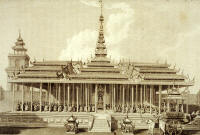
Engraving of the Royal Palace in
Ava
2. The City Plan of Ava
The city of Ava was established on an island that was created by
connecting the Irrawaddy on the north and the Myitnge on the east with a
canal on the south and the west. The brick fortifications of Ava do not
follow the conventions of the earlier rectilinear city plans. Instead, the
zigzagged outer walls are popularly thought to outline the figure of a seated lion. The inner
enclosure or citadel was laid out according to traditional cosmological
principles and provided the requisite twelve gates. The inner city was
reconstructed on at least three occasions in 1597, 1763, and 1832.
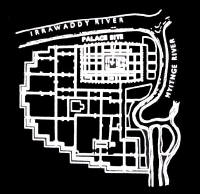
City Plan of Ava
3. Architecture
Buildings constructed during the Ava Period perpetuate the "Burmese"
types of stupa, temple, and monastery that had evolved at Pagan. However,
in comparison to the interest in building and renovating stupas, very few
temples were erected.
a. Temples
There is little that remains of any monuments from the early Ava Period.
One of the few structures that still stand within the walls of Ava is
the Leidatgyi temple that dates from the seventeenth century. Although it
was severely damaged by an earthquake in 1839, it is obvious from its
double fenestration, radial vaulting, the design of its elaborate stucco
work and the seated lions above the main portal that it was intended to be
a copy of the Ananda temple at Pagan.
Slide: Leidatgyi Temple, Ava
- to be added Spring 2003
b. Stupas
Many large stupas were regularly built during the Ava Period although
large temples seem to have fallen from favor. Also, older revered stupas
were often repeatedly enlarged and reconstructed. Among them is the
Htilainshin Stupa in Ava that was built by the great Pagan King Kyanzittha
although its present shape is the cumulative result of many later repairs
and additions. Renovation and refurbishment became so widespread at this
time that the most revered stupas in Burma were transformed into their
present shape, even if the outer surfaces have been more recently
reworked. This includes the Shwedagon in Rangoon, the Shwesandaw in Prome
and the Shwemawdaw in Pegu.
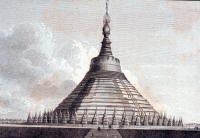
Shwemadaw Stupa, Pegu, Late 18th century
engraving
Stupas during the Ava Period continued the Pagan model although there
were changes in proportion and detail as well as the occasional
innovation. The pervasive trend was to merge the separate elements of the
Pagan model into a continuous conical profile. This was accomplished by
multiplying the number of small stepped tiers between the ground and the
base of the bell and by giving an inclined outline to the lower terraces.
This change became so pervasive that in more recent stupas the shoulder of
the bell and its concave face were suborned to the overall conical shape.
The Htupayon Stupa in Sagaing, begun in approximately 1460 but never
finished, retains the bell-shaped dome of the Pagan period. The rows of
niches, however, that occur in all three of its circular terraces are an
innovation.
Although the Kaunghmudaw Stupa was created in 1636 to commemorate the
establishment of Ava as the royal capitol, it is located across the
Irrawaddy from the city, about six miles northwest of Sagaing. One of the
largest and most unusual stupas to be built during the Ava Period, its
broad, hemispherical, lotus bud-like dome set upon three, circular
terraces is a copy of the famous Mahaceti Stupa in Sri Lanka. The huge
dome measures 151 feet in height and 900 feet in circumference. Only the
lowest terrace of the stupa has niches and each of these was filled with
one of 120 images of spirits (nats) or gods (devas). Another innovation is
found in the ring of 812 stone pillars, measuring five feet high, that
encircle the base, each having a niche to hold an oil lamp. In late
October lamps are placed in each column for the annual Thadingyut Light
Festival that marks the end of Buddhist lent.

Kaungmudaw Stupa
c. Monasteries
The Pagan monastery types constructed of brick and stucco were not
continued after the fourteenth century. Although there are numerous
written records recording the construction of wooden monasteries during
the Ava Period, little remains today of these early structures that were built of
perishable materials.
4. Sculpture
a. The Ava Style Image
During the Ava Period there were fewer contacts with India and
consequently several particularly Burmese image styles evolved. The
typical Ava image was made of marble and was carved completely in the
round. The stele backing so often used at Pagan is rarely seen. The full
and fleshy body is seated on a lotus throne with legs entwined in the
lotus position with the right hand calling the earth to witness (bhumisparsa
mudra). The squarish head has full cheeks and a fig-like finial above the
low usnisha. The ears curve slightly outward and stretch down to touch the
shoulder. A small, thin lipped, puckered mouth is situated just below the
long, broad nose. The eyebrows arch dramatically upward approximating a
semi-circle that may be incised and painted. The half-closed eyes look
down instead of outward and in some images the features seem extremely
child-like. This curious countenance is explained by the Burmese as a way
of indicating that the Buddha manifested the purity of an infant. The
fingers and toes are most often all the same length. Supporting props of
marble may appear between the thumb and the index finger of the same hand
or under the hand or wrist.
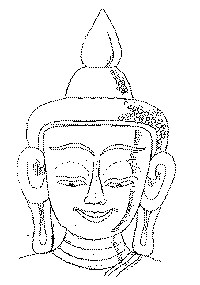 Drawing of Buddha Head, Ava Style – 17th
century |
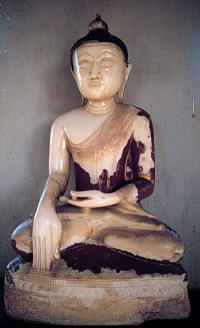 Marble Buddha Image, Ava Style - 17th
century |
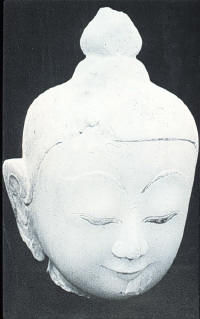 Marble Buddha Head, Ava Style - 17th
century |
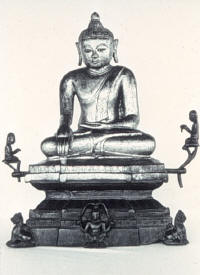
Bronze image, inscribed 1628 |
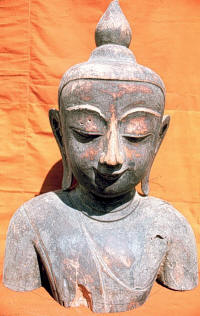
Wooden Buddha image, dated 1640 |
|
b. The Jambupati Image
According to accepted Theravada Buddhist practice, images of Gautama
Buddha appear clothed in unadorned monk’s robes with his hair in small
curls and his body devoid of jewelry. The continuity of this visual
convention is emblematic of his renunciation of this would of desire and
is a reminder of his having sacrificed his material heritage as a crown
prince.
In marked contrast to this strong tradition, there is a cultist
convention in Southeast Asia, which depicts the Buddha in lavish royal
attire and is known as Jambupati Buddha. One possible explanation for this
convention derives from the meeting of the Buddha with King Jambupati. The
haughty King Jambupati lived during the time of the Buddha and with his
boundless power, he terrorized the world. The Buddha requested that
Jambupati forsake evil and practice kindness, but Jambupati was not moved.
Realizing the king’s total reluctance, the Buddha magically appeared in
resplendent royal raiment that so awed Jambupati that he accepted the
Buddhist precepts. In Southeast Asian countries like Burma, where rulers
have very high if not semi-divine status, tales of this type justify the
need for the king to worship the Buddha, the King of Kings.
 Jambupati image, Ava
Style |
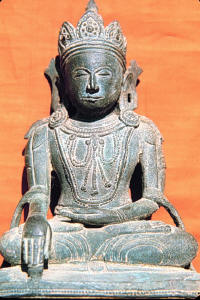 Jambupati
image, Ava Style |
5. Painting
Ava Paintings continued the major religious themes and
subject matter of the Pagan Period while the settings were given a
local context that included contemporary Burmese architecture, dress,
hair-styles, and jewelry as well as local flora and fauna. Scenes from
everyday life included not only court life and palace scenes but commoners
involved in daily activities such as fishing, plowing or making ceramic
pots.
There was a change in format away from small, neatly divided panels to
long registers that allowed for the inclusion of more figures,
particularly of subordinate characters or figures unrelated to the
narrative. The last ten Jatakas were most favored and were presented more
completely in great detail, at times a single Jataka covering an entire
wall.
 The Ananda Ot Kyaung, Exterior |
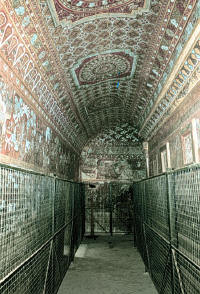 The Ananda Ot Kyaung,
Interior Corridor |
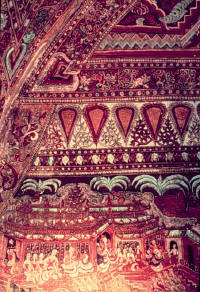 The Ananda Ot Kyaung,
Wall Painting |
 The Ananda Ot Kyaung,
Court Scene |
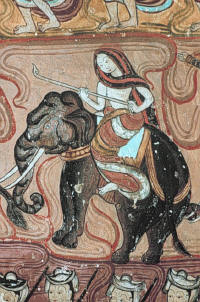 The Ananda Ot Kyaung,
Rider on elephant |
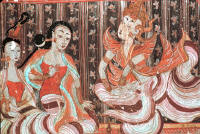 The Ananda Ot Kyaung,
Conversation |
 The Ananda Ot Kyaung, Garuda |
|
New pigments were introduced such as bright reds, yellows, blues but
especially turquoise that produced richer more vivid paintings as seen in
the Tilawkaguru Meditation caves (1672) in Sagaing and the Ananda Brick
Monastery (Ananda Ot Kyaung) and the U Pali Ordination Hall (Thein) in
Pagan.
 Tilawkaguru
Cave Monastery, Exterior |
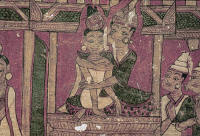 Tilawkaguru
Cave Monastery, Scene in Royal Palace |
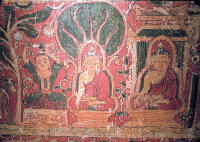 Tilawkaguru
Cave Monastery, The Great tonsure, Two seated Buddha |
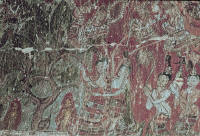 Tilawkaguru
Cave Monastery, The Birth of the Buddha
|
<Next>
<Table of Contents> |